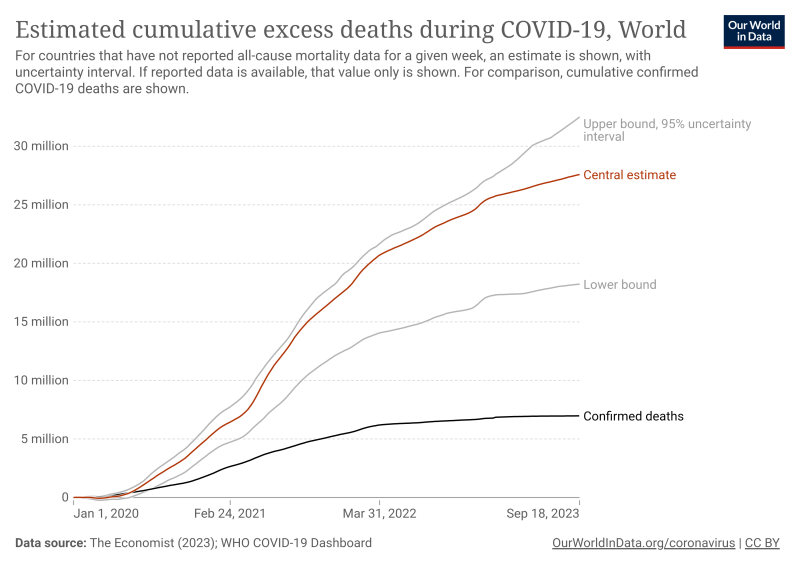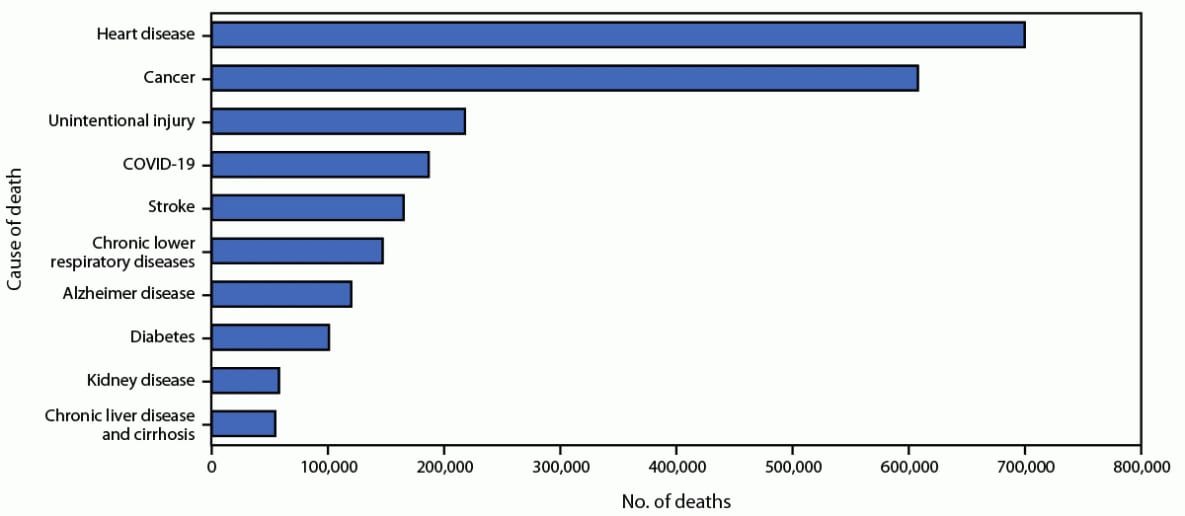
In April, InsuranceNewsNet published a story about the insurance industry forming a coalition nonprofit to study what their headline deemed a "baffling" rise in excess mortality:
Members of the group, called The Insurance Collaboration to Save Lives, say they were increasingly concerned about excess mortality and morbidity trends that even three years after the start of the COVID-19 pandemic, have not returned to pre-pandemic levels.
While the intrepid detectives of the insurance industry figure this out, the World Economic Forum appears to be keeping SARS-CoV-2 risk in mind. It seems a bit dull for Hanlon's razor that an industry that exists to manage risk would just now be catching up.
People dropping dead of covid complications will get lost in the medical noise of other leading causes of death. If you include unintentional injuries complicated by disabilities, there isn't anything in the top 10 causes of death in the United States that covid does not directly contribute to or accelerate.

A class conspiracy wielding a powerful immunological myth cleaved its way into busy hospitals and took doctors for fools.
Maybe you knew your government was never really going to protect you, and you're willing to take your chances because you aren't willing to upend your life in the ways you'd need to in order to protect yourself and your family (assuming you have that kind of privilege in the first place). Where is this widespread contagion camaraderie finding mass appeal, if not the resignation of seeing your own infection and exploitation as inevitable?
After all, we spent 100 years normalizing the survival of flu fevers, because we'd rather not examine the social implications of how fucked up it is that the body's immune system entered a panic mode so severe that it started burning itself alive. How harmful that is to the body each time it happens, and how unnecessary and preventable most influenza transmission is.
Then we spent three years ignoring warnings about the long-term consequences of a virus unconstrained by seasonal patterns, modeling that resignation to our children, resigning them to the fate we resigned ourselves to, and failing to prepare them for the world as it actually is. A world in which kids are dropping dead from subclinical covid complications. No, really. From researchers at Pomeranian Medical University in the journal Diagnostics on September 18:
About 30 days after the confirmation of the mother’s infection, the [seven-year-old] girl, who did not show any clinical symptoms, died in the morning. Characteristic lung changes and molecular testing showed the presence of genetic material of the SARS-CoV-2 virus both in the lungs and in the nasopharynx, with the absence of the S gene in the nasopharyngeal swab.
[...] At the time of autopsy, we did not have any clinical data that would indicate the presence of COVID-19 disease in the deceased. Only the inflammatory picture of the lung tissue, repeated in all analyzed cases, prompted us to perform molecular diagnostics. This shows how little we still know about this virus. How insidious the course of infection can be. How much the condition of a patient who may not even know about the infection can worsen.
Inevitable though, right? Here's a real meat grinder: most children are only getting away with such allegedly insignificant infections because of an abundance of naive T cells, which do not replenish (the thymus, where they are produced, shrinks with age, and there are a finite amount that can be released from bone marrow).
The severity of the acute respiratory syndrome is the severity of the underlying disease, not the symptoms that may or may not display (or be detected). A syndrome can mean symptoms, but it really means indications that you have a disease. This isn't the same as immunogenic symptoms — symptoms from the immune system mounting a response — which are highly variable. In the case of SARS-related coronaviruses, the syndrome is always severe.
We're talking about a virus that, during the acute phase, uses the respiratory system as a launching pad to get to the rest of the body, establishing reservoirs that may never fully clear, vaccinated or not. It is precisely because SARS-CoV-2's immunogenic symptoms can be mistaken for other things that makes it so dangerous. That, and the false negative rate of rapid antigen nasal swabs during the first few, sometimes several days of infection, which is a really phenomenal combination when our entire pandemic response has focused on treating symptoms at the expense of the silent damage the virus is otherwise doing.
Our current public health paradigm assumes that a lifetime of "common" infections is perfectly fine and only a concern with a weakened immune system. The problem with this is that a lifetime of these infections accelerates immunosenescence, weakening the immune system. Most "colds" — over 200 distinct viruses have earned the name — are novel pathogens as far as the immune system is concerned, and finite reserves deplete over time.
Now we have a rampant virus that disrupts the immune system and makes the health burden of all of these colds worse. There is no exit strategy for this.
References:
-
Our World in Data – Estimated cumulative excess deaths during COVID-19,
World - InsuranceNewsNet – Insurance industry coalition forms non-profit to study baffling excess mortality
- Forbes – World Economic Forum: Here Are All The Covid-19 Precautions At Davos 2023
- Arthur Bloch (via Internet Archive) – Murphy's Law, Book Two: More Reasons Why Things Go Wrong!
- [Open-Source Eschaton] – Covid Fact Sheet
- Centers for Disease Control and Prevention – Provisional Mortality Data – United States, 2022
- Red Clarion – Let Them Eat Plague!
- Financial Times (via archive.today) – ‘Immunity debt’ is a misguided and dangerous concept
- Bill of Health – Hospitals That Ditch Masks Risk Exposure
- Forbes – Public Pushes Back On CDC’s Plan To Weaken Infection Control
- Diagnostics – Molecular Diagnosis of COVID-19 Sudden and Unexplained Deaths: The Insidious Face of the Pandemic
- Nature – Local and systemic responses to SARS-CoV-2 infection in children and adults
- eLife – Adaptive Immunity: Maintaining naivety of T cells
